Magnetic Force vs. Electric Force: What's the Difference?
Edited by Aimie Carlson || By Harlon Moss || Updated on October 15, 2023
Magnetic force arises from magnets or moving charges, acting at a distance to attract/repel. Electric force is due to charge interaction, influencing other charges nearby or across a space.

Key Differences
Magnetic force is a phenomenon associated with magnetic fields, which are created by moving electric charges and inherent magnetic dipoles. Electric force, conversely, is a fundamental interaction between objects due to their electric charges, whether stationary or moving.
The magnetic force is always produced by magnets or moving electric charges and acts perpendicular to the motion of charged particles. The electric force arises from electric charges themselves, influencing other charges through the electric field they produce.
Magnetic force can either attract or repel, depending on the orientation of magnetic poles; it does not do work alone. Electric force, in contrast, can do work on charges, either attracting or repelling based on the nature of the charges involved (like repels like, opposites attract).
Magnetic force is described by the Lorentz force law when dealing with moving charges and is integral in electromagnetism. Electric force is foundational in electrostatics, described by Coulomb's Law, illustrating the force between stationary charges.
Magnetic force affects only moving charges or materials sensitive to magnets. Electric force affects all materials with an electric charge, impacting them based on the charge magnitude and distance.
ADVERTISEMENT
Comparison Chart
Source
Magnets or moving charges
Stationary or moving charges
Direction
Perpendicular to motion of charged particles
Along the line connecting two charges
Effect on materials
Only on moving charges or magnetic materials
On all materials with an electric charge
Work
Does not do work alone
Can do work on charges
Fundamental Law
Lorentz force law
Coulomb's Law
ADVERTISEMENT
Magnetic Force and Electric Force Definitions
Magnetic Force
The attraction or repulsion that arises between electrically charged particles because of their motion.
The magnetic force caused the iron filings to align along the lines of force emanating from the magnet.
Electric Force
The interaction between static or moving charges, described quantitatively by Coulomb's Law.
In the atom, the electric force between positively charged protons and negative electrons maintains their orbit.
Magnetic Force
The influence that a magnetic field exerts on moving charges, magnetic materials, or other magnets.
In the motor, the magnetic force acts perpendicular to the electric current, causing rotation.
Electric Force
The force that causes electric charges to attract or repel, influencing the structure of atoms to the design of electric circuits.
Engineers calculate the electric force to create safe, efficient electrical systems.
Magnetic Force
The force exerted by magnets when they attract or repel each other.
Children often play with magnets, feeling the magnetic force push or pull them together.
Electric Force
A non-contact force that acts across space, observable in phenomena like lightning and static electricity.
During the storm, the electric force built up in the clouds discharged as a spectacular lightning bolt.
Magnetic Force
An aspect of the combined electromagnetic force that affects the orientation and behavior of charged particles in motion.
Scientists study the magnetic force to understand its implications in quantum mechanics and cosmology.
Electric Force
A fundamental force of nature that operates between charged particles and bodies.
The electric force lights up cities, powers devices, and is fundamental in modern life.
Magnetic Force
A non-contact force that acts at a distance, observable in the behavior of materials within a magnetic field.
The magnetic force from the Earth's core extends far into space, protecting the planet from solar radiation.
Electric Force
The push or pull between objects arising from their electric charges.
The balloon stuck to the wall due to the electric force between it and the wall's surface.
FAQs
What is a magnetic force?
A magnetic force is the attraction or repulsion occurring between magnets, moving charged particles, or a combination of both.
What is the origin of electric force?
Electric force originates from the fundamental property of matter known as electric charge, either positive or negative.
What constitutes an electric force?
Electric force is the interaction that happens between objects due to the electric charges they carry.
Is electric force visible to us?
Electric force is not visible but its effects, like electric sparks or attraction and repulsion of objects, can be seen.
How pervasive is electric force?
Electric force is ubiquitous, acting between any objects possessing electric charge, whether noticeable or not.
How does a magnetic force arise?
Magnetic force arises from either inherent magnetic fields of magnets or magnetic fields created by moving electric charges.
Can we see magnetic force?
Magnetic force is invisible but can be observed through its effects on materials within a magnetic field.
What technological applications use electric force?
Electric force is foundational in technology, powering electronic devices, and used in fields like telecommunication and computing.
Can magnetic force affect non-magnetic materials?
Magnetic force primarily affects magnetic materials and moving electric charges, with negligible impact on non-magnetic materials.
What happens when magnetic forces are balanced?
When magnetic forces are balanced, there's no net movement, and the system reaches a state of equilibrium.
Can magnetic force do work on objects?
Magnetic force alone does not do work; it changes the direction of moving charges but doesn't change their speed.
Does electric force perform work?
Yes, electric force can do work by moving charged objects, changing their speed or direction.
Is magnetic force present all the time?
Magnetic force is present around magnets or moving charges, evident when interacting with materials sensitive to magnetic fields.
How strong can a magnetic force be?
The strength of a magnetic force depends on the magnet's material and the distance and orientation relative to other magnets or charges.
What determines the strength of an electric force?
Electric force strength depends on the amount of charge involved and the distance between the interacting charges.
Where does natural electric force occur?
Natural electric force occurs in phenomena like lightning, static electricity, and even in biological systems.
What occurs when electric forces achieve equilibrium?
At electric force equilibrium, forces cancel out, resulting in no net force and no movement of charges.
What is the role of magnetic force in technology?
Magnetic force is vital in technology, used in devices like MRIs, motors, and data storage systems.
Does electric force influence neutral objects?
Electric force can influence neutral objects by polarizing them, causing a slight separation of positive and negative charges within.
Are there natural sources of magnetic force?
Yes, natural sources of magnetic force include the Earth's magnetic field and certain minerals like magnetite.
About Author
Written by
Harlon MossHarlon is a seasoned quality moderator and accomplished content writer for Difference Wiki. An alumnus of the prestigious University of California, he earned his degree in Computer Science. Leveraging his academic background, Harlon brings a meticulous and informed perspective to his work, ensuring content accuracy and excellence.
Edited by
Aimie CarlsonAimie Carlson, holding a master's degree in English literature, is a fervent English language enthusiast. She lends her writing talents to Difference Wiki, a prominent website that specializes in comparisons, offering readers insightful analyses that both captivate and inform.
































































